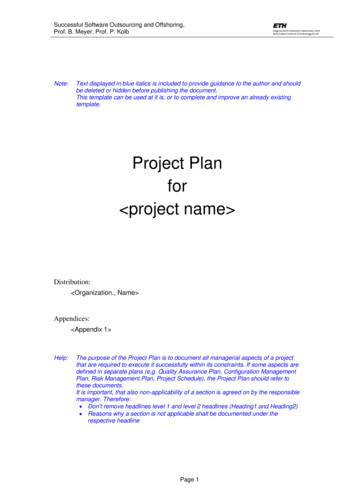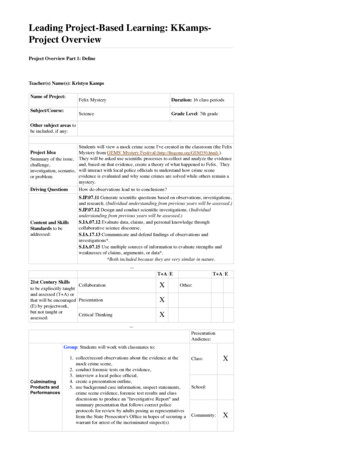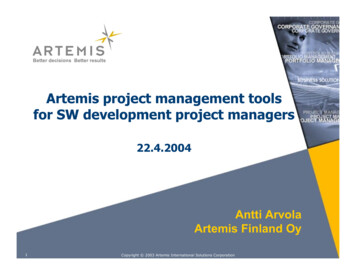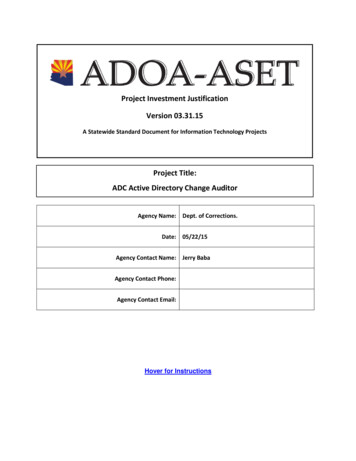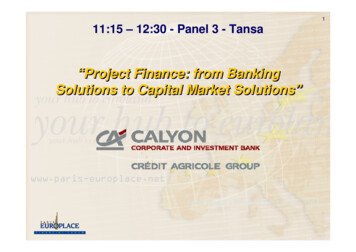
Transcription
AProject ReportOn” In depth study of Derivative Market”In partial fulfillment of summer internship program of 2 years fulltimeMBA Course
Ch.1 INDUSRY OVERVIEWÆ INTRODUCTION:Stock markets refer to a market place where investors can buy and sell stocks.The price at which each buying and selling transaction takes is determined by marketforces (i.e. demand and supply for a particular stock).Exemplify how market forces determine stock prices, take an example of ABCCo. Ltd. which enjoys high investor confidence and there is an anticipation of an upwardmovement in its stock price. More and more people would want to buy this stock (i.e.high demand) and very few people will want to sell this stock at current market price (i.e.less supply). Therefore, buyers will have to bid a higher price for this stock to match theask price from the seller which will increase the stock price of ABC Co. Ltd. On thecontrary, if there are more sellers than buyers (i.e. high supply and low demand) for wn.In earlier times, buyers and sellers used to assemble at stock exchanges to make atransaction but now with the dawn of IT, most of the operations are done electronicallyand the stock markets have become almost paperless. Now investors do not have togather at the Exchanges, and can trade freely from their home or office over the phone orthrough Internet.Stock exchanges to some extent play an important role as indicators, reflecting theperformance of the country’s economic state of health. It is exposed to a high degree ofvolatility; prices fluctuate within minutes and are determined by the demand and supplyof stocks at a given time. Stock brokers are the ones who buy and sell securities on behalfof individuals and institutions for some commission. The Securities and Exchange Boardof India (SEBI) is the authorized body, which regulates the operations of stockexchanges, banks and other financial institutions.
The past performances in the capital markets especially the securities scam by‘Hasrshad Mehta’ has led to tightening of the operations by SEBI. In addition theinternational trading and investment exposure has made it imperative to better operationalefficiency. With the view to improve, discipline and bring greater transparency in thissector, constant efforts are being made and to a certain extent improvements have beenmade.ÆHISTORY:Indian Stock Markets are one of the oldest in Asia. Its history dates back to nearly200 years ago. The earliest records of security dealings in India are meager and obscure.By 1830’s business on corporate stocks and shares in Bank and Cotton presses took placein Bombay. Though the trading list was broader in 1839, there were only half a dozenbrokers recognized by banks and merchants during 1840 and 1850. The 1850’s witnesseda rapid development of commercial enterprise and brokerage business attracted manymen into the field and by 1860 the number of brokers increased into 60.In 1860-61 the American Civil War broke out and cotton supply from UnitedStates of Europe was stopped; thus, the “Share Mania” in India begun. The number ofbrokers increased to about 200 to 250. However, at the end of the American Civil War, in1865, a disastrous slump began (for example, Bank of Bombay share which had touchedRs.2850 could only be sold at Rs.87). At the end of the American Civil War, the brokerswho thrived out of Civil War in 1874, found a place in a street (now appropriately calledas Dalal Street) where they would conveniently assemble and transact business.In 1887, they formally established in Bombay, the “Native Share and StockBrokers’ Association” (which is alternatively known as “The Stock Exchange”). In 1895,the Stock Exchange acquired a premise in the same street and it was inaugurated in 1899.Thus the Stock Exchange at Bombay was consolidated. Thus in the same way, graduallywith the passage of time number of exchanges were increased and at currently it reachedto the figure of 24 stock exchanges.
Æ DEVELOPMENT:An important early event in the development of the stock market in India was theformation of the Native Share and Stock Brokers’ Association at Bombay in 1875, theprecursor of the present-day Bombay Stock Exchange. This was followed by theformation of associations / exchanges in Ahmedabad (1894), Calcutta (1908), andMadras (1937).In order to check such aberrations and promote a more orderly development of thestock market, the central government introduced a legislation called the SecuritiesContracts (Regulation) Act, 1956. Under this legislation, it is mandatory on the part of astock exchanges to seek government recognition. As of January 2002 there were 23 stockexchanges recognized by the central Government. They are located at Ahemdabad,Bangalore, Baroda, Bhubaneshwar, Calcutta, Chenni,(the Madras stock Exchanges ),Cochin, Coimbatore, Delhi, Guwahati, Hyderbad, Indore, Jaipur, Kanpur, Ludhiana,Mangalore, Mumbai(the National Stock Exchange or NSE), Mumbai (The StockExchange), popularly called the Bombay Stock Exchange, Mumbai (OTC Exchange ofIndia), Mumbai (The Inter-connected Stock Exchange of India), Patna, Pune, and Rajkot.Of course, the principle bourses are the National Stock Exchange and The Bombay StockExchange, accounting for the bulk of the business done on the Indian stock market.While the recognized stock exchanges have been accorded a privileged position,they are subject to governmental supervision and control. The rules of a recognized stockexchanges relating to the managerial powers of the governing body, admission,suspension, expulsion, and re-admission of its members, appointment of authorizedrepresentatives and clerks, so on and so forth have to be approved by the government.These rules can be amended, varied or rescinded only with the prior approval of thegovernment. The Securities Contracts (Regulation) Act vests the government with thepower to make enquiries into the affairs of a recognized stock exchange and its business,withdraw the recognition the task of regulating the stock exchange to the SecuritiesExchanges Board of India.
ÆTRADITIONAL BROKING:Traditionally in the stock Market, the investors invest their money in shares underthe guidance of the Brokers of any stock broking company. This is convenient to thoseinvestors who are not familiar with the computer and the use of internet. But it requiresmore dealers to the share broking companies to give guidance related to investment.There was a chance of inaccuracy of price because it is a time consuming process. Thecost of the company also increases due to more paperwork. The investor point of view,there was a problem of privacy. The information of investor may leak by the broker. So,to remove these limitations of traditional broking, there was an emergence of newconcept e-Broking.¾ E- Broking:Electronic trading, sometimes called E-Trading, is a method of tradingsecurities (such as stocks, and bonds), foreign currency, and exchange traded derivativeselectronically. It uses information technology to bring together buyers and sellers throughelectronic media to create a virtual market place.As we know, historically, stock markets were physical locations where buyers andsellers met and negotiated. With the improvement in communications technology, theneed for a physical location is of diminishing importance as the buyers and sellers canelectronically exchange indications of interests as well as negotiate from a remotelocation. Electronic trading makes transactions easier to complete, monitor, clear, andsettle. These are major drivers for most market regulators to insist that all marketseventually must be developed electronicallyThe significance of the E broking increases day by day due to the benefits likereduction in the cost of transactions, Greater liquidity, Greater competition, IncreasedTransparency etc.
¾ Demat Account:Dematrefers to adematerialized account.to offer the securities in both physical andsecurities in either mode.Though the company is under obligationdemat mode,you have the choice to receive theIf you wish to have securities in demat mode, you need toindicate the name of the depository and also of the depository participant with whom youhavedepositoryaccountinyourapplication.It is, however desirable that you hold securities in demat form as physicalsecurities carry the risk of being fake, forged or stolen. Just as you have to open anaccount with a bank if you want to save your money, make cheque payments etc,Nowadays, you need to open a demat account if you want to buy or sell stocks.So it is just like a bank account where actual money is replaced byto approach theDPsshares.(remember, they are like bank branches), to open yourYou havedemat account.Let's say your portfolio of shares looks like this: 150 of Infosys, 50 of Wipro, 200 of HLL and100 of ACC. All these will show in yourdemat account.physical certificates showing that you own these shares.your account.As youbuy and sell the shares,So you don't have to possess anyThey are all held electronically inthey are adjusted in your account. Just like abank passbook or statement, the DP will provide you with periodic statements of holdings andtransactions.In India, a demat account, the abbreviation for dematerialised account, is a type ofbanking account which dematerializes paper-based physical stock shares. Thedematerialised account is used to avoid holding physical shares: the shares are boughtand sold through a stock broker.
¾ Procedure:1. Fill the demat request form (DRF) (obtained from a depository participant or DP withwhom your depository account is opened).2. Deface the share certificate(s) you want to dematerialize by writing across Surrenderedfor dematerialization.3. Submit the DRF & share certificate(s) to DP. DP would forward them to the issuer /their R&T Agent.4. After dematerialization, your depository account with your DP, would be credited withthe dematerialized securities. Benefits: Immediate transfer of securities No stamp duty on transfer of securities Elimination of risks associated with physical certificates such as bad delivery Reduction in paperwork involved in transfer of securities Reduction in transaction cost bonus/split/consolidation/merger etc. Holding investments in equity and debt instruments in a single account.of
Æ TRANSACTION CYCLE:Decision totradePlacingOrderTransactionCycleFunds orSecuritiesSettlement oftradesTradeExecutionClearing ofTradesA person holding assets (Securities/Funds), either to meet his liquidity needs or toreshuffle his holdings in response to changes in his perception about risk and return of theassets, decides to buy or sell the securities. He selects a broker and instructs him to placebuy/sell order on an exchange. The order is converted to a trade as soon as it finds amatching sell/buy order. At the end of the trade cycle, the trades are netted to determinethe obligations of the trading member’s securities/funds as per settlement cycle.Buyer/seller delivers funds/ securities and receives securities/funds and acquiresownership of the securities. A securities transaction cycle is presented above. Justbecause of this Transaction cycle, the whole business of Securities and Stock Broking hasemerged. And as an extension of stock broking, the business of Online Stock broking/Online Trading/ E-Broking has emerged.
ÆDEPOSITORY:A depository is like a bank wherein the deposits are securitis (shares, debentures,bonds, government securities etc.) in an electronic form. Depository interacts with itsclients / investors through its agents, called Depository Participants normally known asDPs. No. of Depository in the country:Currently there are two depositories operational in the country.1. National Securities Depository Ltd. (NSDL)2. Central Depository Services Ltd. (CDSL) Services provided by Depository: Dematerialization (usually known as demat) is converting physical certificates toelectronic form Rematerialization, known as remat, is reverse of demat, i.e. getting physicalcertificates from the electronic securities Transfer of securities, change of beneficial ownership Settlement of trades done on exchange connected to the Depository Electronic credit in public offering of the Companies Non - Cash corporate benefits, viz. Bonus / Rights - direct credit into electronicform
Æ FIVE FORCE ANALYSISPOTENTIAL ENTERANTFinancial ComaniesBanksForeign PlayersSUPPLIERSWeb Mutual Funds CompaniesSmall InvestorsFranchise/BusinessPartnersMF CompaniesHUFInstitutionalInvestorsInsurance CompaniesBanksSUBSTITUTESMutual FundsInsuranceBank FD
Ch. 2 STOCK EXCHANGESÆ INTRODUCTION:The Security Contract (Regulation) Act, 1956 [SCRA] defines Stock Exchange asany Body of Individuals, whether incorporated or not, constituted for the purpose ofassisting, regulating or controlling the business of buying, selling or dealing in Securities.Stock Exchange could be a Regional Stock Exchange whose area of operations isspecified at the time of its recognition or national exchanges, which are permitted to havenationwide trading since inception. NSE was incorporated as a National Stock Exchangeand similarly BSE as a Bombay Stock Exchange.In short we can say that Stock Exchange is nothing but a common platform wherebuyers and sellers come together to transact in stocks and share. It may be a physicalentity where brokers trade on a physical floor via an “Open Outcry” system or a VirtualEnvironment.Æ INDICES:An Index is a comprehensive measure of market trends, intended for investors whoare concern with general stock market price movements. An Index comprises Stocks thathave Large Liquidity and Market Capitalization. Each stock is given a weightage in theIndex equivalent to its market capitalization.The Index of NSE is known as NIFTY while the Index of BSE is known asSENSEX. At the NSE, the capit
In partial fulfillment of summer internship program of 2 years fulltime MBA Course . Ch.1 INDUSRY OVERVIEW Æ INTRODUCTION: Stock markets refer to a market place where investors can buy and sell stocks. The price at which each buying and selling transaction takes is determined by market forces (i.e. demand and supply for a particular stock). Exemplify how market forces determine stock prices .




